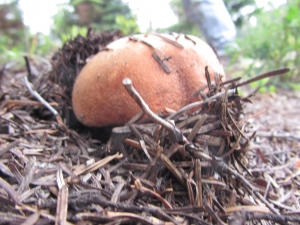
Boletus edulis
The King Bolete is a very popular mushroom and carries different names. It is one of the most sought after mushrooms, fresh or dried. This mushroom can be found in the late spring, during Morel season, and summer in higher elevations. They are found in lower elevations after the fall rains. The King Bolete has dense pores instead of gills under their cap. This can make the mushroom meatier if in good condition and dry. But if the pores are wet they can become mushy during cooking so need to be discarded. When drying King Boletes remove the pores and dry separately to use in soups and gravy’s when reconstituted. Make sure the stems are firm when selecting your King Boletes ,not hollow feeling or mushy, this can be a sign of worms. Cook your boletes well as they have been known to cause upset stomachs. When grilling, brush with butter or oil and make sure the cap is fully cooked. Sprinkle with Parmesan cheese just before removing from the grill for added flavor.
To preserve King Boletes canning is alright but remove the pores under the cap first. Dry the pores separately from the cap and stems so you can reconstitute them separately. Soak your Bolete tubers over night, rinse thoroughly to remove any sand, strain the reconstituted liquid and use in your recipe. Wring your tubers out to get as much of the liquid as possible before tossing them out. To thicken the liquid use a roux and season with salt. You then have essence of edulis which you can dilute for sauces, gravy’s and soups.
The King Bolete mushroom cap can be sticky or dry, colored brown to yellow, red brown or dark red and bald. The underside of the cap is like a sponge or porous layer that is white when young turning yellowish, brown or olive when mature. The stalk is thick, with a bulb when young, white to brown but never yellow. The flesh is white, not staining blue or brown when cut. The taste of the King Bolete is mild and nutty, never bitter.